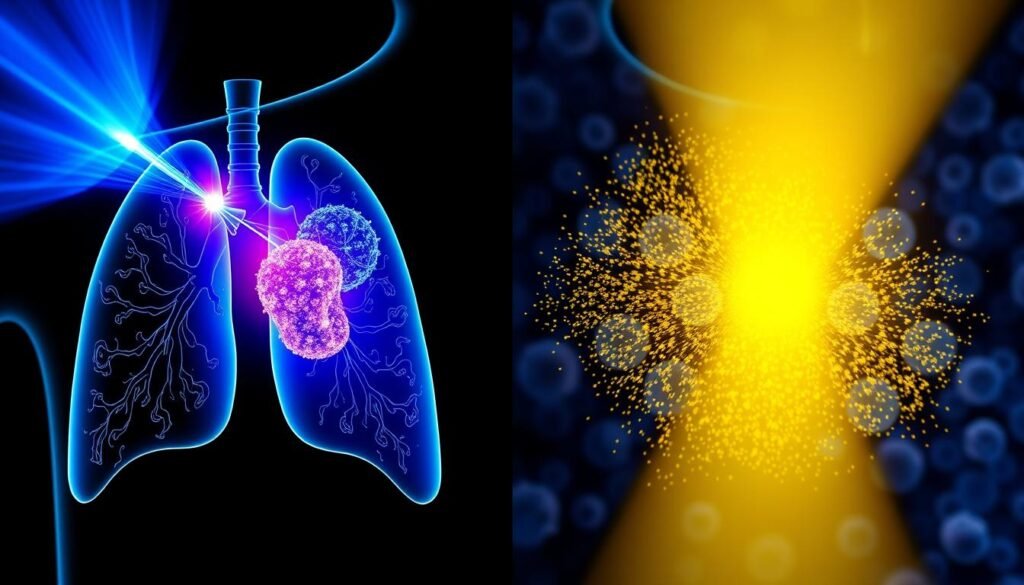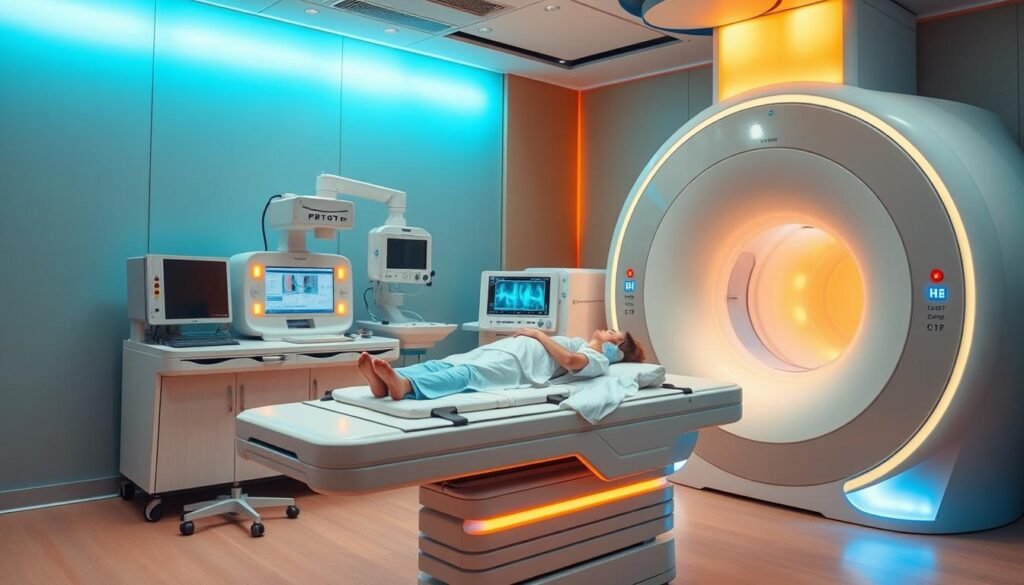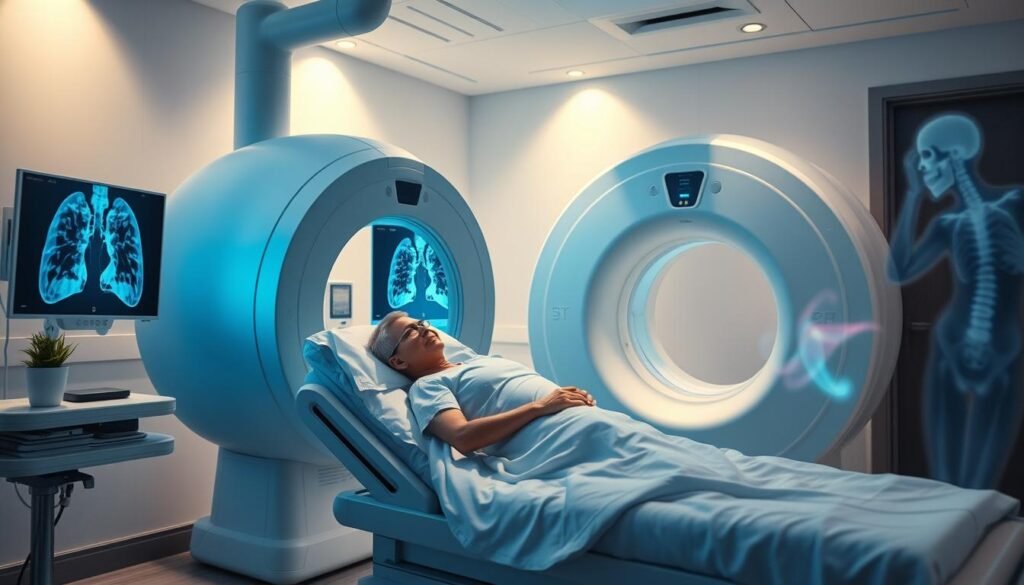Lung cancer is a leading cause of cancer deaths, making up almost 25% of all cases in North America. Its five-year survival rate is low, at just 24%. This makes finding effective treatments vital. Proton therapy, especially at places like the MD Anderson Proton Therapy Center, offers hope. It sends strong radiation doses right to the tumor. This spares important areas like the heart and lungs. Patients see better quality of life and treatment results.
Key Takeaways
- Lung cancer is the leading cause of cancer-related deaths in North America.
- Proton therapy targets tumors precisely, minimizing damage to healthy tissue.
- Studies show that patients experience fewer severe side effects with proton therapy.
- Proton therapy may be particularly beneficial for inoperable lung cancer patients.
- Leading cancer centers are increasingly adopting proton therapy for lung cancer treatment.
Introduction to Proton Therapy
Proton therapy is a new solution in advanced radiation treatment. It uses protons, which are positively charged particles. These protons deliver energy right to the cancerous tissues.
Unlike traditional radiation, proton therapy doesn’t harm nearby healthy cells. It’s great for cancers close to important organs. This precision is key for treating lung tumors.
The treatment usually takes a few weeks, with sessions five days a week. Each session lasts about 15 to 30 minutes. But the actual radiation takes just a few minutes.
The rest of the time is for prep and getting the patient ready. This method targets tumor cells well and keeps healthy tissues safe.
Proton therapy is becoming more popular, but it’s not available everywhere. There are only a few places that offer it. Patients might have to travel far for treatment.
It’s important to talk to healthcare providers before starting. They can help with treatment plans, costs, and insurance. Not all insurance plans cover proton therapy.
In summary, proton therapy is effective and reduces side effects. It targets tumors while protecting healthy tissue. It’s valuable in fighting lung cancer.
The Importance of Lung Cancer Treatment
Lung cancer is a major health concern with a high death rate. Each year, around 234,030 new cases are expected in the United States. Most of these are non-small cell lung cancer (NSCLC). Many are already in advanced stages when diagnosed. This highlights the need for better treatment options.
Proton therapy is changing how we fight lung cancer. It’s a cutting-edge form of radiation that protects the heart and esophagus from damage. By limiting radiation to these organs, proton therapy reduces the risk of future heart issues. This is crucial for patients’ long-term health.
The use of pencil-beam scanning (PBS) in proton therapy ups its game. It delivers precise beams that target tumors while saving healthy tissue. Even for those who’ve had radiation before, proton therapy could be an option. It offers a chance for more treatment when needed.
Studies show proton therapy has clear benefits for lung cancer patients, especially in NSCLC. It’s better at sparing vital organs from high doses of radiation. Nearly 60% of patients with advanced NSCLC need radiation. Here, proton therapy shows its strength.
As this technology evolves, its role in treating lung cancer grows. Already, over 200,000 patients globally have been treated with proton therapy. Continuous research and tech improvements are crucial. They help improve how we treat lung cancer.
How Does Proton Therapy Work?
Proton therapy focuses a beam of protons directly on cancerous tumors. It is great for treating different lung cancers, including proton radiation therapy lung nodules. This therapy is special because it targets the tumor. It spares the healthy tissues around it. Techniques like image guidance and pencil beam scanning make sure the treatment fits the tumor’s shape perfectly.
Studies show that proton therapy can aim higher doses of radiation right at the cancer. This means it could be more effective. For example, it’s been found better than traditional radiation in protecting important organs like the heart and esophagus. A study in 2018 found it could also cause less damage to healthy lung tissue. Plus, patients treated with proton therapy often have better survival rates and fewer side effects.
The use of proton therapy is expanding rapidly. More places are offering it, and there’s a lot of research backing it up. In the US, improvements to the proton therapy process are leading to better results. This is especially true for patients who can’t have surgery or face tougher lung cancer battles.
Benefits of Proton Therapy for Lung Cancer
Proton therapy is a promising option for treating lung cancer. It offers unique benefits over traditional radiation. This method greatly lowers the risk to healthy tissues nearby, resulting in fewer side effects. Patients may face less lung inflammation and fewer heart problems. They also might have less trouble swallowing. These upsides lead to a better treatment experience for patients.
Proton therapy can pinpoint tumors more accurately, sparing nearby organs. This precision improves tumor control and could help patients live longer. Also, there’s less risk of harm to healthy tissues, which means a better life after treatment.
About 238,340 Americans will be diagnosed with lung cancer this year. Sadly, around 127,070 might not survive. In Texas alone, 14,510 new cases are expected. This highlights the need for effective treatments like proton therapy. It improves chances of surviving one of the deadliest cancers and addresses a significant health challenge.
| Benefits of Proton Therapy | Traditional Radiation Therapy |
|---|---|
| Reduced radiation exposure to healthy tissues | Higher risk of damaging surrounding organs |
| Higher radiation doses delivered directly to tumors | Limited ability to target just the tumor |
| Improved quality of life post-treatment | Potential for increased side effects |
| Lower incidence of lung inflammation and heart complications | Higher incidence of complications |
The value of proton therapy for lung cancer is growing. It offers an effective treatment with fewer side effects. As lung cancer diagnoses increase, using innovative treatments is crucial. They boost survival rates and enhance life quality for many.
Does Proton Therapy Work for Lung Cancer?
Proton therapy is being recognized as an effective treatment for lung cancer. It is especially considered for certain kinds like localized non-small cell lung cancer and small cell lung cancer. People often ask: does this therapy help with lung cancer? Studies show that it indeed has positive effects on patients.
Understanding Proton Therapy Efficacy
Proton therapy can target cancer cells with high doses of radiation while protecting healthy organs. This method has led to better treatment results for lung cancer patients. Also, when combined with chemotherapy, it has improved survival rates compared to standard treatments. Another benefit is its ability to reduce side effects, which improves patients’ quality of life significantly.
Advancements in Research and Clinical Trials
Current research and clinical trials on proton therapy for lung cancer continue to explore its benefits. These trials cover various cancer types, showing how versatile proton therapy is. Facilities like Proton International London specialize in this treatment, making it more accessible. They focus on personalized care, ensuring patients receive the best possible results from their therapy journey.
| Factors | Proton Therapy | Traditional Photon Therapy |
|---|---|---|
| Radiation Dose Precision | High precision targeting | Less targeted, higher risk to healthy tissue |
| Treatment Duration | Two to eight weeks, five days a week | Varies, potentially longer |
| Side Effects | Reduced risk, lower toxicity | Higher risk of radiation-related side effects |
| Organ Preservation | Better preservation of surrounding organs | Less effective in preserving healthy tissue |
| Clinical Trial Support | Ongoing trials confirming efficacy | Established history but fewer recent advancements |
Proton Therapy vs. Photon Radiation in Lung Cancer Treatment
Knowing the difference between proton and photon radiation is key for lung cancer treatment. Proton therapy is special because it targets more precisely. It sends energy right to the tumor, not harming healthy tissue around it much.
Research shows proton therapy means less radiation to organs like the heart and lungs. A study with 289 patients showed those with proton therapy got lower radiation doses. They still had good disease control.
Analysis shows a 94.0% success in stopping cancer growth over 2 years with proton therapy. The overall survival rate was 83.0%. This proves proton therapy can be safer with less harm.
Proton therapy’s Pencil Beam Scanning focuses directly on tumors. It reduces bad effects. Only 21% got serious lung issues with proton therapy, unlike 40% with photons.

Those with lung cancer should think about safety, side effects, and effectiveness when choosing a treatment. Check online for more on proton therapy’s benefits at lung cancer treatment options.
Who is a Candidate for Proton Therapy?
Finding out who can get proton therapy for lung cancer needs a deep look at health and cancer specifics. Usually, it’s for those with early lung cancer or cancer that hasn’t spread far. It works best for tumors that haven’t moved beyond the chest.
This treatment helps when the tumor is local and solid. It’s good near vital organs. Proton therapy protects healthy tissue from damage.
Those who had radiation before or have other big health problems might still get this therapy. The tumor’s location near important organs is key to deciding. A full health review decides the right treatment plan.
- Proton therapy is particularly beneficial for:
- Patients with solid tumors near critical organs.
- Individuals needing radiation in areas that have previously undergone treatment.
- Patients unable to receive traditional radiation due to cumulative side effects.
- Pediatric patients, due to reduced long-term radiation risks.
- Candidates for proton therapy must undergo rigorous evaluations to confirm suitability.
- Less than 50 cancer centers in the United States offer proton beam therapy, limiting access for many.
Proton therapy is especially good for kids. It lowers the long-term risks that come with radiation. More types of cancer, like lung and GI tract cancers, are now treated with it. Research keeps adding more cancers to the list.
Proton Therapy Treatment Process
The proton therapy treatment process ensures personalized care for every patient. At first, an evaluation looks at medical history and imaging. This helps specialists design a treatment plan. The goal is to target the tumor and save healthy tissue around it.
Initial Consultation and Evaluation
In the first meeting, patients talk with their healthcare provider about their illness and treatment aims. Imaging tech is key here, helping to pick the best proton therapy approach. Understanding each patient’s unique situation allows the medical team to plan for the best results with few side effects.
Treatment Planning and Delivery
The next step is planning the treatment. Providers use cutting-edge methods like IMPT with Pencil Beam Scanning. They can aim the dose at the tumor very precisely. Then, the patient goes through several sessions over six to seven weeks. These sessions aim protons at the cancer, killing cells while keeping healthy tissue safe.

This careful approach with proton therapy aims to cut down on side effects like nausea and lung inflammation. Those interested in this cancer treatment can explore further. They can also talk to a proton nurse navigator to see if they’re eligible and learn more about treatment options.
Success Rates and Outcomes of Proton Therapy
Several studies show how effective proton therapy is for lung cancer. One important study by Penn Medicine involved around 1,500 patients. It showed that those getting proton therapy had fewer severe side effects in the first 90 days.
Only 11.5% of these patients reported serious side effects. This is less than the 27.6% in the X-ray group.
Survival rates are also better with proton therapy. After one year, 83% of proton therapy patients were still alive, compared to 81% in the X-ray group. This means proton therapy is better at managing side effects and improving survival rates. Plus, the chance of severe side effects was two-thirds less.
Proton therapy gives results similar to X-ray radiation in survival and cancer control. A large review showed it has fewer side effects for many cancer types. This brings hope for the future treatment of lung cancer with proton therapy.
As more data comes in, the role of proton therapy in treating lung cancer becomes clearer. It could greatly improve patient outcomes. This study makes proton therapy a good option for lung cancer patients. It targets tumors well without harming nearby healthy tissues.
Potential Side Effects and Considerations
Proton therapy targets lung cancer accurately. But, it’s essential to know side effects can still happen. Understanding these effects is key as patients go through their treatment. This way, they can keep up their quality of life while managing side effects.
Common Side Effects
The side effects of proton therapy for lung cancer differ from one person to another. Some may feel fatigue or notice skin reactions like redness. Others might experience pain near the treatment area.
- Fatigue: Many feel tired for days or even weeks after their treatment.
- Skin Reactions: Skin changes, such as redness or irritation, may occur, known as dermatitis.
- Localized Pain: Some may feel discomfort around the treated area, impacting daily life.
Knowing these side effects helps patients be ready and get the right care when needed. There are ways to lessen these symptoms, including certain therapies and medicines. Patients respond differently to treatment, so care must be tailored to each person.

| Side Effect | Description | Management Strategies |
|---|---|---|
| Fatigue | A pervasive sense of tiredness post-treatment. | Rest, hydration, light exercise. |
| Skin Reactions | Redness or irritation at the treatment area. | Moisturizers, cooling gels, avoiding sun exposure. |
| Localized Pain | Discomfort near the irradiation zone. | Pain relief medications, physical therapy. |
With proper support and knowledge of side effects, patients can handle their treatment better. This approach makes the experience more bearable and informative.
Conclusion
Proton therapy is at the forefront of lung cancer treatment thanks to its precision and reduced side effects. It is especially good for patients with non-small cell and small cell lung cancer. They see improved quality of life with targeted radiation. Studies show it leads to better survival rates and disease-free times, highlighting its benefits.
Research and trials are making us understand how effective proton therapy can be. Statistics show it can greatly increase survival to 28.2 months. Plus, it lowers the chance of bad side effects compared to traditional therapy. This brings hope to patients, especially those with big tumors or damaged lung function from past treatments.
Proton therapy is changing how we treat cancer, focusing on patient care while fighting tumors. It’s a promising option, making the future look hopeful for lung cancer strategies. This therapy offers not just an advanced treatment but also hope for a better health journey for many.